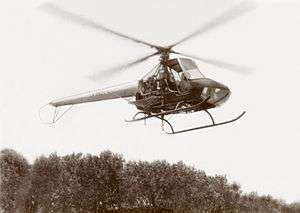Cicaré CK.1
The Cicaré CK.1 (originally, the CH.III Colibrí) was a light helicopter developed in Argentina in the 1970s. It was a small, single-rotor aircraft of pod-and-boom configuration with a fully enclosed bubble canopy that could seat three people side-by-side. Cicaré's previous helicopter designs had attracted the attention of the Argentine Air Force, which in 1974 contracted him to develop a light helicopter for training and also marketed for agricultural use. A prototype, registered LV-X62 flew in September 1976, and the Air Force placed an order for five pre-production machines. However, development was terminated at this point.
| CK.1 | |
|---|---|
 | |
| Role | Utility helicopter |
| Manufacturer | Cicaré |
| Designer | Augusto Cicaré |
| First flight | September 1976 |
| Number built | 1 (+5?) |
Specifications
General characteristics
- Crew: one pilot
- Capacity: 2 passengers
- Length: 8.53 m (28 ft 0 in)
- Main rotor diameter: 7.60 m (24 ft 11 in)
- Height: 8.53 m (28 ft 0 in)
- Main rotor area: 43.8 m2 (471 ft2)
- Empty weight: 469 kg (1,034 lb)
- Gross weight: 800 kg (1,764 lb)
- Powerplant: 1 × Cicaré 4C-27, 149 kW (200 hp)
Performance
- Maximum speed: 163 km/h (101 mph)
- Range: 480 km (298 miles)
- Service ceiling: 3,900 m (12,800 ft)
Armament
See also
- Cicaré CH-14
References
| Wikimedia Commons has media related to Cicaré CK.1. |
- Taylor, Michael J. H. (1989). Jane's Encyclopedia of Aviation. London: Studio Editions. p. 254.
- Jane's All the World's Aircraft 1977-78. London: Jane's yearbooks. pp. 4–5.
- Simpson, R. W. (1998). Airlife's Helicopters and Rotorcraft. Ramsbury: Airlife Publishing. pp. 211–12.
This article is issued from Wikipedia. The text is licensed under Creative Commons - Attribution - Sharealike. Additional terms may apply for the media files.